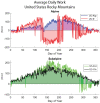Thermodynamic basis for the demarcation of Arctic and alpine treelines
- PMID: 35869102
- PMCID: PMC9307831
- DOI: 10.1038/s41598-022-16462-2
Thermodynamic basis for the demarcation of Arctic and alpine treelines
Abstract
At the edge of alpine and Arctic ecosystems all over the world, a transition zone exists beyond which it is either infeasible or unfavorable for trees to exist, colloquially identified as the treeline. We explore the possibility of a thermodynamic basis behind this demarcation in vegetation by considering ecosystems as open systems driven by thermodynamic advantage-defined by vegetation's ability to dissipate heat from the earth's surface to the air above the canopy. To deduce whether forests would be more thermodynamically advantageous than existing ecosystems beyond treelines, we construct and examine counterfactual scenarios in which trees exist beyond a treeline instead of the existing alpine meadow or Arctic tundra. Meteorological data from the Italian Alps, United States Rocky Mountains, and Western Canadian Taiga-Tundra are used as forcing for model computation of ecosystem work and temperature gradients at sites on both sides of each treeline with and without trees. Model results indicate that the alpine sites do not support trees beyond the treeline, as their presence would result in excessive CO[Formula: see text] loss and extended periods of snowpack due to temperature inversions (i.e., positive temperature gradient from the earth surface to the atmosphere). Further, both Arctic and alpine sites exhibit negative work resulting in positive feedback between vegetation heat dissipation and temperature gradient, thereby extending the duration of temperature inversions. These conditions demonstrate thermodynamic infeasibility associated with the counterfactual scenario of trees existing beyond a treeline. Thus, we conclude that, in addition to resource constraints, a treeline is an outcome of an ecosystem's ability to self-organize towards the most advantageous vegetation structure facilitated by thermodynamic feasibility.
© 2022. The Author(s).
Conflict of interest statement
The authors declare no competing interests.
Figures







Similar articles
-
Limited prospects for future alpine treeline advance in the Canadian Rocky Mountains.Glob Chang Biol. 2018 Oct;24(10):4489-4504. doi: 10.1111/gcb.14338. Epub 2018 Jul 1. Glob Chang Biol. 2018. PMID: 29856111
-
Treeline advances along the Urals mountain range - driven by improved winter conditions?Glob Chang Biol. 2014 Nov;20(11):3530-43. doi: 10.1111/gcb.12613. Epub 2014 Jun 14. Glob Chang Biol. 2014. PMID: 24756980
-
Warming-induced upward migration of the alpine treeline in the Changbai Mountains, northeast China.Glob Chang Biol. 2018 Mar;24(3):1256-1266. doi: 10.1111/gcb.13963. Epub 2017 Nov 27. Glob Chang Biol. 2018. PMID: 29080270
-
[Progresses of alpine treeline formation mechanism.].Ying Yong Sheng Tai Xue Bao. 2016 Sep;27(9):3035-3041. doi: 10.13287/j.1001-9332.201609.010. Ying Yong Sheng Tai Xue Bao. 2016. PMID: 29732870 Review. Chinese.
-
Predicted responses of arctic and alpine ecosystems to altered seasonality under climate change.Glob Chang Biol. 2014 Oct;20(10):3256-69. doi: 10.1111/gcb.12568. Epub 2014 Jun 2. Glob Chang Biol. 2014. PMID: 24599697 Review.
Cited by
-
Multispectral Remote Sensing Data Application in Modelling Non-Extensive Tsallis Thermodynamics for Mountain Forests in Northern Mongolia.Entropy (Basel). 2023 Dec 13;25(12):1653. doi: 10.3390/e25121653. Entropy (Basel). 2023. PMID: 38136533 Free PMC article.
References
-
- Richardson AD, Friedland AJ. A review of the theories to explain arctic and alpine treelines around the world. J. Sustain. For. 2009;28:218–242. doi: 10.1080/10549810802626456. - DOI
-
- Callaghan, T. V., Werkman, B. R. & Crawford, R. M. M. The tundra-taiga interface and its dynamics: concepts and applications. Ambio. Special Report Number 12, 6–14. http://www.jstor.org/stable/25094570 (Springer, 2002). - PubMed
-
- Holtmeier F-K, Broll G. Treeline research-from the roots of the past to present time. A review. Forests. 2020;11:38. doi: 10.3390/f11010038. - DOI
-
- Wardle P. An explanation for alpine timberline. N. Z. J. Bot. 1971;9:371–402. doi: 10.1080/0028825X.1971.10430192. - DOI
-
- Shi P, Körner C, Hoch G. A test of the growth-limitation theory for alpine tree line formation in evergreen and deciduous taxa of the eastern Himalayas. Funct. Ecol. 2008;22:213–220. doi: 10.1111/j.1365-2435.2007.01370.x. - DOI
Publication types
MeSH terms
LinkOut - more resources
Full Text Sources

